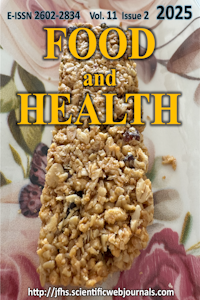Abstract
Bu çalışmada ülkemizde kullanılan 28 adet yerel ve ithal susam tohumunda ve bu susam çeşitlerinden üretilerek satışa sunulan 21 adet tahin ürününde ICP-MS yöntemi ile toplamda 20 farklı mineralin analizi gerçekleştirildi. Susam ve tahin numuneleri ayrıca Türk Gıda Kodeksin susam ve tahin tebliğinde yer alan bazı fiziksel ve kimyasal analizler bakımından da test edilerek numunelerin kodekse uygunlukları incelendi. Araştırmada test edilen susam ve tahin örneklerinin fiziksel ve kimyasal özellikleri büyük oranda tahin ve susam tebliğinde belirtilen değerlerle uyum içerisindedir. Susam tohumlarının mineral içerikleri yerli ve ithal susam bazında çeşitlilik göstermekle birlikte kalsiyum, potasyum, fosfor ve magnezyum miktar olarak en çok bulunan minerallerdir. Susam numunelerinde bulunan ağır metallerin ortalama miktarları arsenik için 0.062, kurşun 0.075, kadmiyum 0.090, cıva 0.113 ve antimon 0.172 mg/kg olarak tespit edilmiştir. İthal ve yerli susamdan üretilen tahin numunelerinin mineral içeriklerinin oldukça değişkenlik gösterdiği belirlenmiştir. Türk Gıda Kodeksi Tahin Tebliğinde tahin için belirtilen değerler dikkate alındığında (Arsenik miktarı en çok 0.2 mg/kg, kurşun en çok 0.3 mg/kg, bakır en çok 18 mg/kg ve demir ise en çok 75 mg/kg); arsenik ve kurşun miktarlarının tüm numunelerde limit altında olduğu, bakır miktarının dört numunede ve demir miktarının ise yedi numunede değerlendirme limitinin üzerinde olduğu tespit edilmiştir. Çalışmada elde edilen verilere göre mineral içeriği susam tohumunun menşeine, rengine ve çeşidi gibi değişkenlere bağlı olarak farklılıklar göstermektedir.
Keywords
Ethical Statement
Araştırma niteliği bakımından etik izne tabii değildir. Veriler talep üzerine sağlanacaktır.
Supporting Institution
Balıkesir Üniversitesi Bilimsel Araştırma Projeleri (BAP) Birimi
Project Number
BAP:2023-108
Thanks
Araştırmada kullanılan susam ve tahin numunelerinin temini konusunda TUNAS Gıda Pazarlama ve Tic. Ltd. Şti. çalışanlarına teşekkür ederiz. ICP-MS cihazının kullanımında gösterdikleri destek için Balıkesir Gıda Kontrol Laboratuvar Müdürlüğüne teşekkür ederiz.
References
- Akbulut, M., Çoklar, H. (2008). Physicochemical and rheological properties of sesame pastes (tahin) processed from hulled and unhulled roasted sesame seeds and their blends at various levels. Journal of Food Process, 31, 488-502. https://doi.org/10.1111/j.1745-4530.2007.00162.x
- Anonim (2001). TS 2133 ISO 930 Baharat ve çeşni veren bitkiler- Asitte çözünmeyen kül muhtevası tayini. Türk Standartları Enstitüsü, Ankara.
- Anonim (2005-a). TS 2947 EN ISO 658. Yağlı tohumlar- Yabancı madde muhtevasının tahsisi. Türk Standartları Enstitüsü, Ankara.
- Anonim (2005-b). TS 311 Susam Tohumu. Türk Standartları Enstitüsü, Ankara.
- Anonim (2015). Türk Gıda Kodeksi Tahin Tebliği (Tebliğ No:2015/27). Türk Standartları Enstitüsü, Ankara.
- Anonim (2022). Türk Gıda Kodeksi, Baharat Tebliği (Tebliğ No:2022/7). Türk Standartları Enstitüsü, Ankara.
- Anonim (2023). Türk Gıda Kodeksi, Bulaşanlar Yönetmeliği. Türk Standartları Enstitüsü, Ankara.
- AOAC (2005). Official methods of analysis of the AOAC (18th ed.). Association of Official Analytical Chemists. Washington, DC.
- Badu, M., Pedavoah, M.M., Dzaye, I.Y. (2020). Proximate composition, antioxidant properties, mineral content and anti-nutritional composition of Sesamum indicum, Cucumeropsis edulis and Cucurbita pepo seeds grown in the savanna regions of Ghana. Journal of Herbs, Spices & Medicinal Plants, 26(4), 329-339. https://doi.org/10.1080/10496475.2020.1747581
- Bamigboye, A.Y., Okafor, A.C. Adepoju, O. T. (2010). Proximate and mineral composition of whole and dehulled Nigerian sesame seed. African Journal of Food Science and Technology, 1(3), 71-75.
- El-Adawy, T.A., Mansour, E.H. (2000). Nutritional and physicochemical evaluations of tahina (sesame butter) prepared from heat-treated sesame seeds. Journal of the Science of Food and Agriculture, 80, 2005-2011. https://doi.org/10.1002/1097-0010(200011)80:14<2005::AID-JSFA740>3.0.CO;2-J
- FAO/WHO (2001). Food and Agricultural Organization of the United Nations/World Health Organization, Human Vitamins and Minerals Requirements. Report of a joint expert consultation on human vitamins and mineral requirements, Bangkok, Thailand.
- FAOSTAT (2022). Food and Agriculture Organization of the United Nations. Crops and livestock products. https://www.fao.org/faostat/en/#data/QCL (Erişim tarihi 15.02.2025).
- FDA (2023). Daily Value and Percent Daily Value on the Nutrition and Supplement Facts Labels. https://www.fda.gov/food/nutrition-facts-label/daily-value-nutrition-and-supplement-facts-labels (Erişim tarihi 15.02.2025).
- Hahm, T.S., Park, S.J., Lo, Y.M. (2009). Effects of germination on chemical composition and functional properties of sesame (Sesamum indicum L.) seeds. Bioresource Technology, 100, 1643-1647. https://doi.org/10.1016/j.biortech.2008.09.034
- Hao, X., Zhou, D., Wang, Y., Shi, F., Jiang, P. (2011). Accumulation of Cu, Zn, Pb, and Cd in edible parts of four commonly grown crops in two contaminated soils. International Journal of Phytoremediation, 13(3), 289-301. https://doi.org/10.1080/15226514.2010.483260
- Hika, W.A., Atlabachew, M., Amare, M. (2023). Geographical origin discrimination of Ethiopian sesame seeds by elemental analysis and chemometric tools. Food Chemistry, 17, 1-7. https://doi.org/10.1016/j.fochx.2022.100545
- Kurt, C. (2018). Tohum kabuğu renginin susam tohumlarında bulunan demir içeriği düzeyine etkisi. KSÜ Tarım ve Doğa Dergisi, 21(5), 686-690. https://doi.org/10.18016/ksudobil.403601
- Labban, L., Sumainah, G. (2021). The Nutritive and Medicinal Properties of Tahini: A Review. International Journal of Nutrition Sciences, 6(4), 172-179. https://doi.org/10.30476/ijns.2021.90294.1123
- Mi, S., Wang, Y., Zhang, X., Sang, Y., Wang, X. (2022). Authentication of the geographical origin of sesame seeds based on proximate composition, multi-element and volatile fingerprinting combined with chemometrics. Food Chemistry, 397, 1-9. https://doi.org/10.1016/j.foodchem.2022.133779
- NMKL (2007). Nordic-Baltic Committee on Food Analysis Method 186. Trace elements - As, Cd, Hg,Pb and other elements. Determination by ICP-MS after Pressure Digestion.
- Nzikou, J.M., Matos, L., Bouanga-Kalou, G., Ndangui, C. B., Pambou-Tobi, N. P. G., Kimbonguila, A. (2009). Chemical composition on the seeds and oil of sesame (Sesamum indicum L.) grown in congo-brazzaville. Advance Journal of Food Science and Technology, 1(1), 6-11.
- Özcan, M.M., Uslu, N., Dursun, N. (2023). The effect of sesame seed processing steps on bioactive properties, nutraceutics and mineral contents of sesame seed, sesame paste (tehina) and oils. Food and Humanity, 1(1) 710-715. https://doi.org/10.1016/j.foohum.2023.07.013
- Roy, B., Pal, A.K., Basu, A.K. (2021). Assessment of genetic divergence of Sesame seeds based on biochemical parameters. Plant Science Today, 8(1), 1-8. https://doi.org/10.14719/pst.2021.8.1.752
- Saeed, F., Qamar, A., Nadeem, M.T., Ahmed, R.S., Arshad, M.S. Afzaal, M. (2015). Nutritional composition and fatty acid profile of some promising sesame cultivars, Pakistan Journal of Food Sciences, 25(2), 98-103.
- Samur, G. (2008). Vitaminler, mineraller ve sağlığımız. Sağlık Bakanlığı Yayın No: 727, Klasmat Matbaacılık, Ankara.
- Teboul, N., Gadri, Y., Berkovich, Z., Reifen, R., Peleg, Z. (2020). Genetic architecture underpinning yield components and seed mineral–nutrients in sesame. Genes, 11(10), 1221. https://doi.org/10.3390/genes11101221
- Thomas, R. (2013). Practical Guide to ICP-MS A Tutorial for Beginners, Boca Raton, FL: CRC Press. https://doi.org/10.1201/b14923
- TUİK (2022). Türkiye İstatistik Kurumu. https://biruni.tuik.gov.tr/medas/?locale=tr).(Erişim tarihi 15.02.2025).
- Zhang, H., Miao, H., Wei, L., Chun, L., Zhao, R. Wang, C. (2013). Genetic Analysis and QTL Mapping of Seed Coat Color in Sesame (Sesamum indicum L.). Plos One, 21(8), e63898. https://doi.org/10.1371/journal.pone.0063898
Abstract
In this study, 20 different minerals were analysed using the ICP-MS method in 28 domestic and imported sesame seeds used in our country, and 21 tahini products were produced from these sesame varieties and offered for sale. Samples of sesame and tahini were tested for various physical and chemical analyses outlined in the Turkish Food Codex, and the compliance of these samples with the codex was assessed. The physical and chemical properties of the analysed sesame and tahini samples largely align with the values specified in the tahini and sesame codex. Although the mineral contents of analysed sesame seeds vary based on local and imported sesame, calcium, potassium, phosphorus, and magnesium are the most abundant minerals. The average values of heavy metals in sesame samples were determined as arsenic 0.062, lead 0.075, cadmium 0.090, mercury 0.113 and antimony 0.172 mg/kg. It was determined that the mineral contents of tahini samples produced from imported and domestic sesame seeds varied considerably. Considering the values given for tahini in the Turkish Food Codex Tahini Communiqué (maximum amount of arsenic is 0.2 mg/kg, maximum amount of lead is 0.3 mg/kg, maximum amount of copper is 18 mg/kg, and maximum amount of iron is 75 mg/kg); it was determined that arsenic and lead results were appropriate in all samples, four samples in copper analysis and seven samples in iron analysis were above the evaluation limit. According to the data obtained in the study, mineral content varies depending on variables such as the origin, colour and variety of sesame seed.
Keywords
Ethical Statement
Due to its nature, the research is not subject to ethical permission.
Supporting Institution
Balikesir University Scientific Research Projects (BAP) Unit
Project Number
BAP:2023-108
Thanks
We would like to thank the employees of TUNAS Food Marketing and Trade Co. Ltd. for providing the sesame and tahini samples used in the research. We would like to thank Balıkesir Food Control Laboratory Directorate for their support in the use of the ICP-MS device.
References
- Akbulut, M., Çoklar, H. (2008). Physicochemical and rheological properties of sesame pastes (tahin) processed from hulled and unhulled roasted sesame seeds and their blends at various levels. Journal of Food Process, 31, 488-502. https://doi.org/10.1111/j.1745-4530.2007.00162.x
- Anonim (2001). TS 2133 ISO 930 Baharat ve çeşni veren bitkiler- Asitte çözünmeyen kül muhtevası tayini. Türk Standartları Enstitüsü, Ankara.
- Anonim (2005-a). TS 2947 EN ISO 658. Yağlı tohumlar- Yabancı madde muhtevasının tahsisi. Türk Standartları Enstitüsü, Ankara.
- Anonim (2005-b). TS 311 Susam Tohumu. Türk Standartları Enstitüsü, Ankara.
- Anonim (2015). Türk Gıda Kodeksi Tahin Tebliği (Tebliğ No:2015/27). Türk Standartları Enstitüsü, Ankara.
- Anonim (2022). Türk Gıda Kodeksi, Baharat Tebliği (Tebliğ No:2022/7). Türk Standartları Enstitüsü, Ankara.
- Anonim (2023). Türk Gıda Kodeksi, Bulaşanlar Yönetmeliği. Türk Standartları Enstitüsü, Ankara.
- AOAC (2005). Official methods of analysis of the AOAC (18th ed.). Association of Official Analytical Chemists. Washington, DC.
- Badu, M., Pedavoah, M.M., Dzaye, I.Y. (2020). Proximate composition, antioxidant properties, mineral content and anti-nutritional composition of Sesamum indicum, Cucumeropsis edulis and Cucurbita pepo seeds grown in the savanna regions of Ghana. Journal of Herbs, Spices & Medicinal Plants, 26(4), 329-339. https://doi.org/10.1080/10496475.2020.1747581
- Bamigboye, A.Y., Okafor, A.C. Adepoju, O. T. (2010). Proximate and mineral composition of whole and dehulled Nigerian sesame seed. African Journal of Food Science and Technology, 1(3), 71-75.
- El-Adawy, T.A., Mansour, E.H. (2000). Nutritional and physicochemical evaluations of tahina (sesame butter) prepared from heat-treated sesame seeds. Journal of the Science of Food and Agriculture, 80, 2005-2011. https://doi.org/10.1002/1097-0010(200011)80:14<2005::AID-JSFA740>3.0.CO;2-J
- FAO/WHO (2001). Food and Agricultural Organization of the United Nations/World Health Organization, Human Vitamins and Minerals Requirements. Report of a joint expert consultation on human vitamins and mineral requirements, Bangkok, Thailand.
- FAOSTAT (2022). Food and Agriculture Organization of the United Nations. Crops and livestock products. https://www.fao.org/faostat/en/#data/QCL (Erişim tarihi 15.02.2025).
- FDA (2023). Daily Value and Percent Daily Value on the Nutrition and Supplement Facts Labels. https://www.fda.gov/food/nutrition-facts-label/daily-value-nutrition-and-supplement-facts-labels (Erişim tarihi 15.02.2025).
- Hahm, T.S., Park, S.J., Lo, Y.M. (2009). Effects of germination on chemical composition and functional properties of sesame (Sesamum indicum L.) seeds. Bioresource Technology, 100, 1643-1647. https://doi.org/10.1016/j.biortech.2008.09.034
- Hao, X., Zhou, D., Wang, Y., Shi, F., Jiang, P. (2011). Accumulation of Cu, Zn, Pb, and Cd in edible parts of four commonly grown crops in two contaminated soils. International Journal of Phytoremediation, 13(3), 289-301. https://doi.org/10.1080/15226514.2010.483260
- Hika, W.A., Atlabachew, M., Amare, M. (2023). Geographical origin discrimination of Ethiopian sesame seeds by elemental analysis and chemometric tools. Food Chemistry, 17, 1-7. https://doi.org/10.1016/j.fochx.2022.100545
- Kurt, C. (2018). Tohum kabuğu renginin susam tohumlarında bulunan demir içeriği düzeyine etkisi. KSÜ Tarım ve Doğa Dergisi, 21(5), 686-690. https://doi.org/10.18016/ksudobil.403601
- Labban, L., Sumainah, G. (2021). The Nutritive and Medicinal Properties of Tahini: A Review. International Journal of Nutrition Sciences, 6(4), 172-179. https://doi.org/10.30476/ijns.2021.90294.1123
- Mi, S., Wang, Y., Zhang, X., Sang, Y., Wang, X. (2022). Authentication of the geographical origin of sesame seeds based on proximate composition, multi-element and volatile fingerprinting combined with chemometrics. Food Chemistry, 397, 1-9. https://doi.org/10.1016/j.foodchem.2022.133779
- NMKL (2007). Nordic-Baltic Committee on Food Analysis Method 186. Trace elements - As, Cd, Hg,Pb and other elements. Determination by ICP-MS after Pressure Digestion.
- Nzikou, J.M., Matos, L., Bouanga-Kalou, G., Ndangui, C. B., Pambou-Tobi, N. P. G., Kimbonguila, A. (2009). Chemical composition on the seeds and oil of sesame (Sesamum indicum L.) grown in congo-brazzaville. Advance Journal of Food Science and Technology, 1(1), 6-11.
- Özcan, M.M., Uslu, N., Dursun, N. (2023). The effect of sesame seed processing steps on bioactive properties, nutraceutics and mineral contents of sesame seed, sesame paste (tehina) and oils. Food and Humanity, 1(1) 710-715. https://doi.org/10.1016/j.foohum.2023.07.013
- Roy, B., Pal, A.K., Basu, A.K. (2021). Assessment of genetic divergence of Sesame seeds based on biochemical parameters. Plant Science Today, 8(1), 1-8. https://doi.org/10.14719/pst.2021.8.1.752
- Saeed, F., Qamar, A., Nadeem, M.T., Ahmed, R.S., Arshad, M.S. Afzaal, M. (2015). Nutritional composition and fatty acid profile of some promising sesame cultivars, Pakistan Journal of Food Sciences, 25(2), 98-103.
- Samur, G. (2008). Vitaminler, mineraller ve sağlığımız. Sağlık Bakanlığı Yayın No: 727, Klasmat Matbaacılık, Ankara.
- Teboul, N., Gadri, Y., Berkovich, Z., Reifen, R., Peleg, Z. (2020). Genetic architecture underpinning yield components and seed mineral–nutrients in sesame. Genes, 11(10), 1221. https://doi.org/10.3390/genes11101221
- Thomas, R. (2013). Practical Guide to ICP-MS A Tutorial for Beginners, Boca Raton, FL: CRC Press. https://doi.org/10.1201/b14923
- TUİK (2022). Türkiye İstatistik Kurumu. https://biruni.tuik.gov.tr/medas/?locale=tr).(Erişim tarihi 15.02.2025).
- Zhang, H., Miao, H., Wei, L., Chun, L., Zhao, R. Wang, C. (2013). Genetic Analysis and QTL Mapping of Seed Coat Color in Sesame (Sesamum indicum L.). Plos One, 21(8), e63898. https://doi.org/10.1371/journal.pone.0063898
Details
| Primary Language | Turkish |
|---|---|
| Subjects | Food Properties, Food Safety, Traceability, Certification and Authenticity |
| Journal Section | Research Article |
| Authors | |
| Project Number | BAP:2023-108 |
| Early Pub Date | March 21, 2025 |
| Publication Date | March 28, 2025 |
| Submission Date | February 18, 2025 |
| Acceptance Date | March 15, 2025 |
| Published in Issue | Year 2025 Volume: 11 Issue: 2 |
Journal is licensed under a
CreativeCommons Attribtion-ShareAlike 4.0 International Licence 


Diamond Open Access refers to a scholarly publication model in which journals and platforms do not charge fees to either authors or readers.
Open Access Statement:
This is an open access journal which means that all content is freely available without charge to the user or his/her institution. Users are allowed to read, download, copy, distribute, print, search, or link to the full texts of the articles, or use them for any other lawful purpose, without asking prior permission from the publisher or the author. This is in accordance with the BOAI definition of open access.
Archiving Policy:
Archiving is done according to ULAKBİM "DergiPark" publication policy (LOCKSS).

